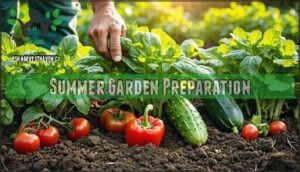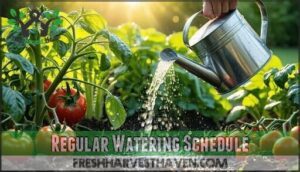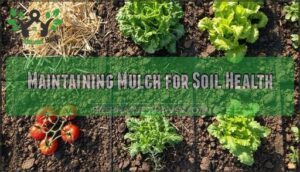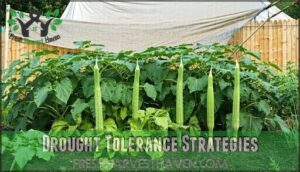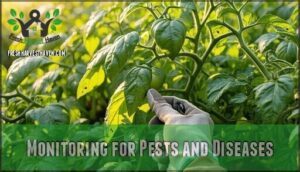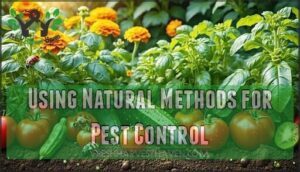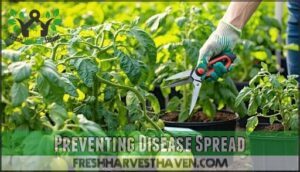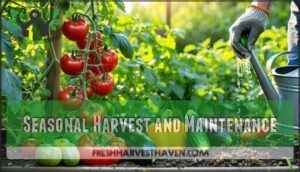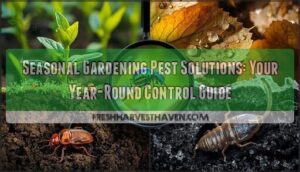This site is supported by our readers. We may earn a commission, at no cost to you, if you purchase through links.
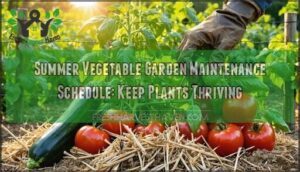
Start by checking soil moisture daily and watering deeply in early morning—plants need one inch weekly in May-June, increasing to two inches in July-September.
Apply mulch around plants to retain moisture and suppress weeds.
Monitor for pests and diseases every few days, catching problems before they spread.
Provide support with stakes or cages as plants grow, and prune dead foliage to prevent disease.
Harvest vegetables regularly to encourage continued production.
The secret lies in timing these tasks strategically throughout the week.
Table Of Contents
- Key Takeaways
- Summer Garden Preparation
- Watering and Mulching
- Pest and Disease Management
- Plant Health and Support
- Seasonal Harvest and Maintenance
- Frequently Asked Questions (FAQs)
- How often should I fertilize vegetables in summer?
- What is the gardening 3 year rule?
- Should I water my vegetable garden every day in the summer?
- What is the rule of 3 in gardening?
- Should you water vegetables every day in summer?
- What is the most common mistake of first time gardeners?
- How often should I water my vegetable garden during a heat wave?
- How often should I water my vegetable garden?
- What is the best time to harvest vegetables?
- How can I protect plants from extreme heat?
- Conclusion
Key Takeaways
- Water deeply but less frequently – You’ll need 1-2 inches weekly, checking soil moisture daily and watering in the early morning to reduce evaporation and prevent root stress.
- Apply thick mulch layers consistently – You should maintain 2-3 inches of organic mulch around plants to retain moisture, suppress weeds, and keep soil temperatures cool during hot weather.
- Monitor for pests and diseases every few days – You cannot afford to wait until problems spread, so inspect plants regularly and remove infected foliage immediately to prevent disease outbreaks.
- Harvest vegetables regularly to boost production – You’ll encourage continuous growth by picking ripe vegetables daily, which signals plants to keep producing throughout the summer season.
Summer Garden Preparation
Preparing your summer garden properly sets the foundation for healthy, productive vegetables throughout the growing season.
Start by testing your soil’s pH and nutrient levels, then amend with compost or fertilizer to create the ideal growing environment your plants need to thrive, ensuring a healthy start with productive vegetables.
Test your soil first, then feed it right—your summer vegetables will thank you with abundant harvests.
Soil Health Assessment
Start your summer vegetable garden maintenance by testing soil health fundamentals.
Check soil nutrient levels using a basic soil test kit, measuring soil pH balance to verify it falls between 6.0-7.0 for ideal vegetable growth.
Assess organic matter content by examining soil texture and color.
Perform a simple soil compaction test by inserting a screwdriver – it should penetrate easily.
Evaluate water retention capacity by observing drainage after watering.
Fertilization Techniques
Once you’ve assessed your soil health, proper fertilizing techniques become your garden’s lifeline.
Summer vegetables need consistent nutrition to handle heat stress and produce abundant harvests. Strategic fertilizer application prevents nutrient deficiencies while avoiding root burn from over-application.
- Soil Testing – Test pH and nutrient levels every 6-8 weeks to guide fertilizer choices
- Organic Amendments – Apply compost or well-rotted manure for slow-release nutrition and improved soil structure
- Nutrient Timing – Fertilize at planting, then every 4-6 weeks during active growing season
Consider using specialized summer fertilizer for ideal growth.
Weed Control Methods
After proper fertilization strengthens your summer vegetables, effective weed control methods become your next priority.
Weeds compete directly with your plants for nutrients, water, and sunlight, making swift action necessary.
| Method | Best For | Timing | Effectiveness |
|---|---|---|---|
| Manual Removal | Small gardens, precise control | Early morning when soil is moist | High for established weeds |
| Organic Herbicides | Broad application, eco-friendly | Before weed germination | Moderate, requires reapplication |
| Soil Solarization | Preventative measures, seed suppression | Pre-planting, hot weather | Very high for soil sterilization |
| Mulching | Weed identification areas, suppression | Throughout growing season | High for prevention |
Manual removal works best when you can grab weeds at their base and pull steadily.
Organic herbicides containing corn gluten meal prevent new seeds from sprouting.
Soil solarization uses clear plastic to heat soil, killing weed seeds before planting your summer garden maintenance schedule begins.
For those preferring a tool, consider using a specialized weed puller for more efficient removal.
Plant Selection and Placement
Strategic placement during summer vegetable gardening transforms your harvest potential.
Consider these five essential factors when planning your garden layout for ideal plant growth:
- Sun Exposure – Match sunlight requirements with available garden areas
- Companion Planting – Group beneficial plants together for natural pest control
- Spacing Needs – Allow adequate room for mature plant size
- Soil Type – Place heavy feeders in nutrient-rich zones
- Crop Rotation – Avoid planting same vegetable families in identical locations
To maximize yields, consider evaluating sunlight conditions before planting.
Watering and Mulching
Water consistently in the early morning to reduce evaporation and keep your vegetables hydrated during hot summer days.
Apply a thick layer of organic mulch around plants to suppress weeds, retain moisture, and maintain cooler soil temperatures throughout the growing season, which helps to keep your vegetables hydrated.
Regular Watering Schedule
During peak summer heat, your vegetable garden requires consistent watering frequency to maintain ideal soil moisture levels.
Water deeply every two to three days rather than daily shallow irrigation, which promotes stronger root development.
Early morning timing strategies offer the most efficient irrigation, reducing evaporation and allowing plants to absorb water before afternoon heat.
Check soil moisture by inserting your finger two inches deep—if dry, it’s time to water, supporting water conservation while ensuring your summer garden care routine keeps vegetables thriving throughout the growing season with ideal soil moisture.
Mulching for Weed Suppression
Beyond consistent garden watering, mulch creates a powerful weed barrier while delivering multiple mulch benefits.
Organic mulch types like straw, wood chips, or shredded leaves work best when applied at proper application depth. This natural approach complements your fertilizing schedule and supports overall pest control efforts.
Consider these top mulch types for maximum weed suppression:
- Straw mulch – blocks light effectively while allowing water penetration
- Wood chips – long-lasting barrier that slowly enriches soil
- Shredded leaves – free option that integrates well with pruning techniques
Apply mulch 2-3 inches deep around plants, keeping it away from stems to prevent vegetable diseases. You can find garden straw products online for your garden.
Maintaining Mulch for Soil Health
Throughout the growing season, mulch decomposition enriches your soil with essential nutrients while supporting beneficial soil microbes.
You’ll need to refresh organic mulch layers as materials break down, maintaining ideal mulch depth for continued water retention and soil health benefits.
| Mulch Type | Refresh Frequency | Depth Maintenance | Decomposition Rate |
|---|---|---|---|
| Straw | Every 6-8 weeks | 2-3 inches | Moderate |
| Wood chips | Every 3-4 months | 3-4 inches | Slow |
| Grass clippings | Every 2-3 weeks | 1-2 inches | Fast |
| Shredded leaves | Every 4-6 weeks | 2-3 inches | Moderate |
The refresh frequency and decomposition rate of different mulch types vary, making it essential to choose the right type for your specific needs and to maintain it properly for optimal soil health benefits.
Drought Tolerance Strategies
Water conservation starts with smart plant selection and deep watering techniques that encourage strong root systems.
Choose drought-resistant varieties like okra and sweet potatoes, which need 40% less water than traditional crops.
Enhance your soil with compost amendments to boost water retention, and create shade using cloth structures during peak summer heat.
These summer gardening tips transform dry conditions into manageable maintenance schedules, using techniques like deep watering and drought-resistant varieties.
Pest and Disease Management
Summer heat brings unwelcome garden guests that can quickly destroy months of hard work if left unchecked.
Summer heat turns your thriving garden into a battlefield against hungry pests.
You’ll need to stay vigilant and act fast when pests and diseases appear, using smart prevention strategies and natural controls to keep your vegetables healthy and productive.
Monitoring for Pests and Diseases
Regular inspections form the backbone of effective summer garden pest control and disease prevention.
Walk through your vegetable garden maintenance schedule every few days, checking leaves, stems, and soil for signs of trouble. Early detection saves you time and protects your harvest.
Look for yellowing leaves, holes, sticky residue, or unusual spots that signal common pests or diseases.
Integrated management combines organic solutions with smart observation, making your summer gardening tips more effective than reactive treatments alone, through early detection and smart observation.
Identifying Insect Pests
Spotting common garden pests early helps protect your summer vegetable garden maintenance efforts.
Look for these telltale signs that reveal unwelcome visitors lurking among your plants:
- Chewed leaves with irregular holes – Caterpillars, beetles, and slugs leave distinctive feeding patterns that help identify the culprit.
- Tiny stippling or yellowing foliage – Spider mites and aphids create characteristic damage patterns before populations explode.
- Wilting despite adequate moisture – Root-feeding grubs or stem borers often cause mysterious plant decline.
- Egg clusters on leaf undersides – Finding pest lifecycle stages early prevents major infestations from developing.
Using Natural Methods for Pest Control
Once you’ve spotted troublesome insects, you can fight back using nature’s own arsenal.
Companion planting with marigolds and basil creates a living fortress around your vegetables, while beneficial insects like ladybirds become your garden’s pest patrol.
Natural sprays made from neem oil or garlic work effectively without harsh chemicals.
Organic barriers and crop rotation complete your integrated approach to sustainable gardening.
Preventing Disease Spread
Despite your best efforts, disease can still sneak into your summer garden maintenance schedule like an uninvited guest. Focus on airflow importance by spacing plants properly and pruning dense foliage.
Practice strict sanitation practices by cleaning tools between plants and removing infected material immediately. Implement crop rotation annually and choose resistant varieties when possible.
Consider using apps to aid in garden pest identification. Early detection through regular monitoring keeps small problems from becoming garden disasters.
Plant Health and Support
Supporting your vegetable plants properly prevents many common problems that can derail your summer harvest.
You’ll need to remove dead foliage, provide structural support, thin overcrowded areas, and prune strategically to keep diseases from spreading through your garden.
This approach will help maintain a healthy garden and prevent the spread of disease, ensuring a successful summer harvest.
Removing Dead Leaves and Foliage
Beyond managing pests and diseases, maintaining clean foliage becomes your next priority in summer garden maintenance.
Dead and yellowing leaves invite trouble, blocking air circulation and creating perfect hideouts for unwanted visitors. Regular removal keeps your plants breathing easy while boosting their photosynthesis impact.
- Fungal prevention: Remove yellowing leaves immediately to stop spore spread
- Pest hiding spots: Clear debris where insects love to camp out
- Air circulation: Pruning opens pathways for healthy airflow through plants
- Aesthetic improvement: Clean plants simply look better and more productive
Staking and Caging Plants
Once you’ve cleared away dead foliage, tall plants need proper support systems to thrive during peak summer growth.
Vertical growth requires strategic planning to prevent collapsed stems and optimize garden space.
One key element of a successful garden is maintaining healthy soil health.
| Plant Type | Support Method | Timing |
|---|---|---|
| Tomatoes | Heavy-duty cages or stakes | Early in growing season |
| Beans/Peas | Trellises or pole systems | Before vines reach 6 inches |
| Peppers | Lightweight cages | When plants reach 12 inches |
Choose staking materials based on plant weight and growth habits.
Caging techniques work best for bushy vegetables, while individual stakes suit single-stem plants.
Install support systems early to avoid root damage later.
Thinning Overcrowded Seedlings
Once you’ve supported your growing plants, overcrowded seedlings need attention for healthy summer gardening.
Proper seedling spacing prevents competition for nutrients and light. Use sterilized tools to avoid root disturbance when removing weaker plants.
Consider replanting thinned seedlings in bare spots for continuous harvesting throughout the growing season.
- Check spacing requirements – Most vegetables need 2-6 inches between plants depending on variety
- Remove weakest seedlings first – Keep the strongest, most vigorous plants in each cluster
- Water before and after – Moistened soil reduces root disturbance during the thinning process
- Provide post-thinning care – Apply light fertilizer and maintain consistent moisture for recovery
Pruning Plants for Disease Prevention
Regular pruning techniques remove infected foliage before diseases spread throughout your summer garden.
Sterilizing tools with alcohol between cuts prevents pathogen transfer, while proper wound treatment through clean, angled cuts helps plants heal quickly.
Improved air circulation from selective pruning boosts plant immunity by reducing humidity that fungi love, and this summer garden maintenance schedule practice substantially reduces disease pressure through proper wound treatment.
Seasonal Harvest and Maintenance
Summer’s peak season requires steady attention to keep your garden productive and healthy.
You’ll need to balance regular harvesting with ongoing maintenance tasks that guarantee continuous growth through the hottest months.
Harvesting Vegetables Regularly
Knowing when your vegetables reach maturity separates novice gardeners from seasoned pros who maximize peak flavor.
Check plants daily during summer’s prime growing weeks, harvesting at ideal timing to extend harvest seasons.
Tomatoes picked when shoulders turn color will ripen indoors, while beans taste best when pods snap crisply.
Smart storage methods prevent waste and keep your summer garden producing abundantly, ensuring a longer harvest season.
Planting Summer Cover Crops
Summer cover crops offer your garden a strategic break while boosting soil health.
After harvesting spent crops, these green allies work overtime to prepare your beds for fall planting through natural soil improvement and erosion control.
- Buckwheat and crimson clover provide rapid nitrogen fixation while suppressing weeds
- Summer legumes like cowpeas enhance crop rotation benefits for future garden planning
- Fast-growing varieties establish quickly in warm weather, maximizing seasonal gardening benefits
These living mulches transform empty beds into productive spaces, setting up your garden care routine for autumn success.
Consider soil erosion prevention when selecting your cover crop.
Transplanting Vegetables for Continuous Production
Transplant new seedlings every 2-3 weeks for uninterrupted summer harvests.
Succession planting maximizes garden productivity by staggering plantings throughout the season.
Harden off seedlings for 7-10 days before transplanting to boost survival rates.
Minimize root disturbance using biodegradable pots, and transplant during early morning to reduce heat stress and create ideal microclimate considerations for continuous production, ensuring uninterrupted summer harvests.
Adjusting Fertilizer Based on Plant Needs
As your summer garden matures, different vegetables demand varying nutrients, making targeted fertilizing essential for peak performance.
Monitor for nutrient deficiency signs like yellowing leaves or stunted growth, then adjust your approach accordingly.
Heavy feeders like tomatoes need regular organic fertilizer options, while lighter feeders require less frequent applications.
Test soil monthly to guide your plant-specific needs and seasonal maintenance decisions effectively.
Frequently Asked Questions (FAQs)
How often should I fertilize vegetables in summer?
Surprisingly, plants crave nutrients just like we crave morning coffee.
You’ll need to fertilize your vegetables every 3-4 weeks during growing season, using balanced fertilizer to keep them thriving and productive.
What is the gardening 3 year rule?
You’ll rotate crops from the same family to different spots every three years.
This breaks pest cycles and prevents nutrient depletion, keeping your garden healthier and more productive naturally.
This process is aided by understanding crop rotation benefits.
Should I water my vegetable garden every day in the summer?
You don’t need to water daily.
Check soil moisture first – stick your finger two inches deep. If it’s dry, water deeply but less frequently.
Most vegetables need about one inch weekly, including rainfall.
What is the rule of 3 in gardening?
Picture your garden as a well-orchestrated symphony where timing creates harmony.
The rule of 3 in gardening means you’ll plant three seeds per hole, thin to the strongest seedling, ensuring ideal spacing and backup options for successful germination and growth.
Should you water vegetables every day in summer?
You don’t need to water vegetables daily in summer.
Check soil moisture by sticking your finger two inches deep – if it’s dry, water deeply.
Most vegetables prefer thorough, less frequent watering.
What is the most common mistake of first time gardeners?
Like plants drowning in kindness, you’re probably overwatering your vegetables.
Most first-time gardeners think daily watering shows love, but it actually suffocates roots and invites disease.
Check soil moisture first—water only when it’s dry.
How often should I water my vegetable garden during a heat wave?
Water your vegetable garden twice daily during heat waves—early morning and evening.
Check soil moisture by sticking your finger two inches deep. If it’s dry, your plants are thirsty and need a drink.
How often should I water my vegetable garden?
Water your vegetables daily during hot weather, checking soil moisture by sticking your finger two inches deep. If it’s dry, water thoroughly at the base of plants early morning.
What is the best time to harvest vegetables?
Gardens whisper their readiness like clockwork – harvest vegetables early morning when they’re crisp and cool, checking daily for peak ripeness.
You’ll catch them at their flavor pinnacle before heat saps their energy.
How can I protect plants from extreme heat?
Shield your vegetables by providing shade cloth, deep watering early morning, mulching heavily around plants, and installing temporary covers during peak heat hours. These tactics prevent wilting and stress damage.
Conclusion
Picture rows of vibrant tomatoes heavy with fruit, lush pepper plants reaching skyward, and crisp lettuce thriving despite summer’s heat.
Your dedication to following a structured summer vegetable garden maintenance schedule transforms potential garden struggles into abundant harvests.
Weekly attention to watering, mulching, pest monitoring, plant support, and regular harvesting guarantees your vegetables flourish throughout the season.
Consistent maintenance prevents problems before they start, keeping your garden productive and healthy all summer long.
- https://www.almanac.com/when-water-your-vegetable-garden-watering-chart
- https://www.gardenary.com/blog/the-ultimate-guide-to-summer-gardening
- https://localfood.ces.ncsu.edu/wp-content/uploads/2020/11/Garden-Task-Timeline.pdf?fwd=no
- https://www.reddit.com/r/vegetablegardening/comments/10vzs3z/roughly_how_much_time_does_gardening_take_out_of/
- https://plantersplace.com/just-veggies/general-vegetable-garden-maintenance/

